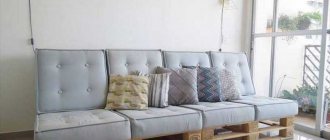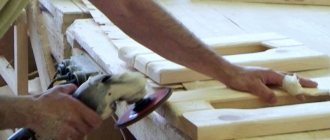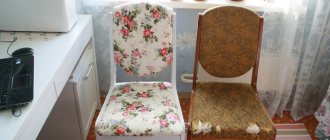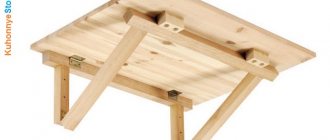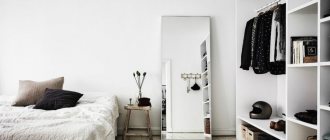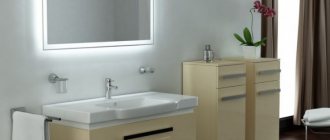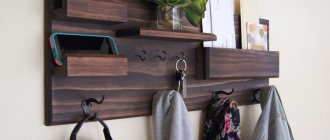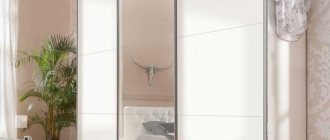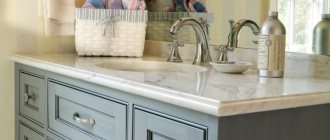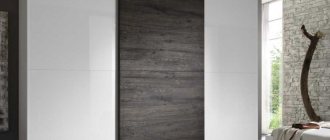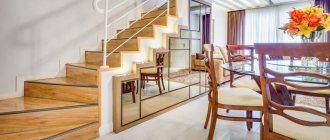How many pairs of shoes do you have? A pair for the spring-autumn season, a pair of winter shoes, summer shoes, sports shoes, executive shoes, as well as flip-flops or slates. That's the minimum. Add your household's shoes to the list. And also those shoes, shoes and boots that you haven’t worn for a long time. And each pair needs its own separate place - after all, shoes need care, care and order. This longread contains the best ways to store shoes, from ready-made solutions that can be found on sale to the original use of improvised means. We have also prepared recommendations on how to properly store shoes so that they look the same as when purchased.
Vintage shoe cabinet
Step-by-step manufacturing instructions
It is impossible to illuminate all types of shoe racks, as well as to predict the individual desires of each master. Therefore, below we talk about making the two simplest shoe cabinets - from wooden plywood and chipboard.
Classic wooden shoe rack
A classic shoe rack can be open or closed, that is, with or without doors. The first one is easier to do, since it requires less materials and time. In addition, the doors must be cut straight, handles attached to them or holes made for ease of opening.
To make a cabinet without doors, you need to do the following:
- Prepare all the components: cut them out and, if necessary, fasten them by gluing or pinning them together.
- First, the internal shelves, the bottom, then the roof, and then the stand and cornice are attached to the frame part.
- Next, the baseboard is attached to the main part, if it is designed according to the drawings, and the back, which may also be missing.
As you can see in the illustration, the second option is not much different from the first, except for the presence of doors. The sequence of actions is the same. The doors are attached last. It is recommended to make a back for the shoe rack, otherwise the design will not look solid.
Chipboard cabinet
Furniture made from chipboard is even easier to make than from other materials. For the shoe rack you will need several parts; they need to be prepared in advance. Just like all the necessary tools.
First, lay out the components on the floor. The first step is to make the body. The walls are connected to the back, bottom, roof, and the baseboards are immediately attached. This is shown schematically in the illustration below.
In the inner part of the walls, the fastenings must be screwed in before assembling the shoe rack. Later other parts are attached to them.
Shoe storage in the hallway: closed cabinets
In the hallway there must be a place for at least those shoes that are often worn this season. A good solution would be to buy a special shoe cabinet. Firstly, they are very compact and convenient, and secondly, they help maintain cleanliness. If you come in after it rains and leave your shoes on the floor or rug before washing them, it makes cleaning much more difficult. After putting your shoes in the shoebox, you can simply wipe down one shelf later. You may not even have to wash your shoes after this, all you have to do is go over them with a cloth.
You can solve this problem by having a plastic tray on hand - it will perform the same function of collecting dirty water. Then you can buy a regular shoe cabinet with shelves or drawers.
Types of shoe racks
According to the type of construction, they are open and closed. The width of furniture for shoes is usually 30-150 cm, height - 50-200 cm, depth - 20-60 cm. Designs with a height of up to 70-80 cm are low, and those with an index of more than 130 are high. Shelves are installed in many places. They can be part of a bench or special boom cabinets designed to accommodate shoes. If you have enough free space, you can think about implementing original storage methods. One of the options for such storage is old boxes in different colors. They are mounted on the wall at a short distance from each other. Beautiful antique chests are also an interesting place to place them. Both designer and authentic ones are equally good. Separately, it is worth noting the modules with special brackets - the space savings in this case are maximum.
The most common options:
- cabinets;
- racks;
- slim shoe racks;
- cabinets;
- Shoes;
- shoe racks.
Shoe cabinet
This is multifunctional furniture, sometimes combined with a wall with hangers, cabinets, stands and other accessories for clothing. This is a convenient solution since many different options will work. Wardrobes only for shoes will be relevant in modular furniture sets. A narrow mirror set, for example, visually enlarges the hallway. The design is also retractable, which allows for fewer movements. A high “showcase” with 2 sections can be considered a typical option. If we are talking about a wardrobe, then a lower pull-out compartment may be provided. The priorities when choosing furniture for storing shoes should be spaciousness and convenience. Therefore, options with low shelf heights and maximum heights are the most practical. A shoe closet can accommodate up to 15 shelves, each of which contains more than 10 pairs.
Shelving
Long, well-placed shelves can accommodate a large number of accessories. This placement method has proven itself well in small boutiques and large shopping centers. Double-sided structures are also used there. At home, to save space, you can install wall shelves. High semicircular options also feature good ergonomics. Shelves come in non-standard shapes: instead of simple flat surfaces, you can see triangular, round, diamond-shaped, etc. When assembling the structure with your own hands, it is easier to make square cells - shoes can be folded in them as tightly as possible. The rack is an equally good solution for corridors, as well as for private rooms and dressing rooms. The disadvantages of these designs are the difficulty in sorting items and maintaining order.
Slim format
This model is characterized by shallow depth. In tight square hallways this is the best option. A distinctive feature of slim shoe racks are the hinged doors. The opening angle should be 30-90 degrees. Convenience depends on the angle: the smaller it is, the more difficult it is to get shoes. However, the angular placement of the shoes themselves does not require great depth of furniture. To use this design usefully, 30 centimeters is usually enough. Only dry and clean shoes should be placed in slim-format shoe racks. This measure is mandatory, because it is possible for an unpleasant odor to form and contaminate other things. In the manufacture of slim cabinets, chipboards and special fittings are mainly used. This version of the shoe rack is usually made as a floor-mounted one, but the wall-mounted method is also used. One of the main disadvantages of such furniture is the lack of space where you could put items for shoe care.
Shoe cabinet
It can be made in the form of a combined version with several sections for storing shoes. This way you can combine open shelves and closed sections, even placement of shoes and at an angle. It is advisable to allocate a small compartment for shoe care products: shoe spoons, creams, etc. It should be borne in mind that a large number of pairs will not fit in the cabinet, and therefore alternatives to this type of use of space are needed. Space saving is achieved due to the openness of the structure. Several wide shelves (for example, 2-3) can accommodate much more than a closed piece of furniture. Moreover, shoes will be constantly available, it will become easier to take them, prepare them, and organize them. If there are more than enough remaining places, you can use a closed cabinet. It should be decorated with decorative colors and various elements.
Galoshnitsa
They are open and closed. The main advantage of the first type is ventilation: the shoes are well ventilated and dry quickly. Its significant drawback is the large amount of dust that collects: cleaning will be frequent and difficult. Closed ones are made in the form of bedside tables and cabinets. They may have holes for ventilation (usually on the back wall). These are the options that are usually chosen. The inner surface is also made of moisture-resistant material, which allows you to place wet shoes there. Some shoe boots are equipped with ultraviolet drying to destroy microbes that negatively affect the smell of products. To ensure that your shoes retain their desired shape, it is better to choose a shoe shoe with adjustable shelf heights. A narrow version of furniture will fit perfectly into the interior of a cramped corridor.
Shoe rack
In racks, shoes can be attached vertically, clinging to special tongues. Other options include lattice surfaces. Some vertical shoe furniture resembles large, wide shelves. The vast majority of racks are open - this makes them much more convenient to use. Closed options are justified if they are narrow and tall. Racks are tall structures, sometimes from floor to ceiling. They are designed to organize a place to store a large number of shoes. Shoe racks can also be rotating. Despite its large size, this interior element has several disadvantages. Firstly, the structure is unstable. Secondly, it is large in size and will be superfluous in small hallways. It is also worth noting the difficulties in cleaning the upper tiers. Dust is more difficult to wipe off there, so it can accumulate for a long time.
Cabinet drawings and dimensions
Initially, before starting the practical part of making furniture, you need to decide on your wishes and draw a diagram. The drawing should indicate the dimensions of future workpieces, if necessary, the number of parts and additional nuances.
It’s worth writing everything down so you don’t forget anything during the process. It is not recommended to rely on your memory, as you can easily confuse the width of two shelves, and the result will not be what you intended.
The easiest way is to take a ready-made drawing and print it. If you have your own ideas that you want to implement, then you can use a ruler, a pencil and experiment. But it’s still advisable to have other diagrams in front of your eyes so that you have something to focus on.
The shoe rack can be large if there is space in the hallway. It is recommended to make the cabinet higher, but narrower. So it will not interfere and will fit into any interior.
Another option is a shoe cabinet, which has additional functionality. For example, it will be both a storage space and an ottoman on which you can sit while getting ready.
There are shoe cabinets with closed shelves, that is, visually they look like bedside tables, no one will see what is there.
More experienced and skilled craftsmen who want to diversify the interior of their apartment or private house can try to make something unusual, non-trivial, different from the classics. Designer shoe racks are rarely sold in stores and cost a lot of money. If you design them yourself, it will turn out even more interesting.
Another unusual but practical solution is to make retractable shelves. That is, when opening the door, all the shoes will be in sight of the person, therefore, he will be able to quickly find his way and pull out the pair he needs. The advantage of such options is that it is very easy to maintain order and cleanliness.
There are also shoe shelves that remain completely open. It’s worth saying right away that it doesn’t always look appropriate; cleanliness must be maintained on a regular basis, that is, surfaces must be washed every day. In addition, the hallway will be in constant chaos, since all things are in plain sight. The only advantage is ease of installation.
A person should make a shoe cabinet with his own hands and drawings for it based on his own needs. There is no need to try to repeat what you saw in the pictures if it is inconvenient in everyday life. But we shouldn’t forget about the aesthetic component either.
